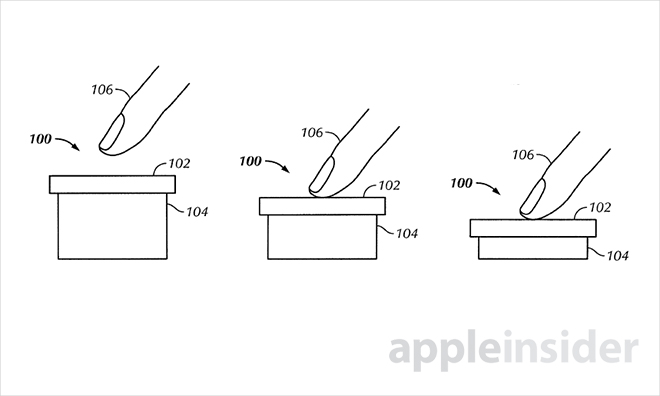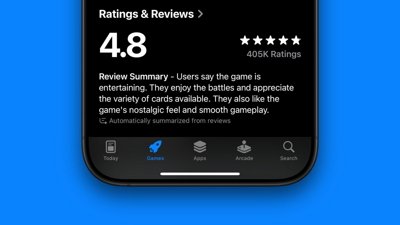The U.S. Patent and Trademark Office on Tuesday published an Apple patent describing a "button" that is not only touch sensitive, but can detect multiple levels of pressure, allowing for an input method advanced beyond anything available today.
Apple broke ground when it unveiled the multitouch-capable iPhone in 2007, offering users a new way to interact with portable electronics. Since then, the company has made a number of advancements, such as software enhancements that allow the iPad and iPad mini to recognize and ignore errant thumb touches, but nothing that would greatly impact how a user interfaces with their device.
The closest thing to a new hardware-based input method is Touch ID, Apple's fingerprint sensor solution deployed in the iPhone 5s. However, that technology deals more with access than interaction.
A recent rumor claims Apple is working on a pressure-sensitive touchscreen that can trigger UI functions based on how hard a user is pressing the glass. Such a system is described in the company's latest granted patent.
With its U.S. Patent No. 8,581,870 for "Touch-sensitive button with two levels," Apple may be on the verge of introducing a new form of input; one that could change the face of iOS.
While a majority of the patent refers to a "button," a notation buried near the end of the document points out that a touch screen operatively coupled to an actuator can be considered a "touch-sensitive depressible button" as described below.
As illustrated in the document, Apple's hybrid touch input invention involves a depressible button with "multiple depression thresholds." The top of this component is touch-sensitive and can generate input signals based on the static location of a finger or gesture events.
Stages of two-level button press with double-dome actuator.When the first of the two or more thresholds is reached, the touch-sensitive portion of the button can be activated, or taken out of low-power mode, thus enabling touch input. In some embodiments, the touch panel will not generate a signal until this first threshold is reached, meaning the component does not output a signal until it is depressed.
This implementation allows for the component to serve multiple functions depending on where it is pressed. For example, a finger press detected on the right area of a touch-sensitive surface outputs a different signal than a finger press captured on the left area.
In addition, this method also allows for energy savings. When the button is not actuated, the touch sensor can remain in a low-power, non-sensing state. Once the first threshold is reached, however, an input signal can be generated as described above.
As noted, multiple thresholds may be employed to ease usability. For example, moving from a non-sensing state to one that generates input signals can take too much time. In this scenario, a first depression level can be a "hair-trigger," causing the touch sensor to activate at the slightest touch. In some cases, the initial depression threshold is so small as to be imperceptible to the user. Alternatively, the underlying actuator can be self-capacitive, in which case a finger touch would replace the first depression.
The second threshold can be reserved for a form of secondary input. In some embodiments, the position of a user's finger can be logged at the same time this second threshold is passed. As in the initial depression, the positioning can be associated with a certain UI action, like the opening of an app.
Apple's patent therefore describes a system that can initiate touch sensing with a first imperceptible press, track a user's gestures or finger movement, then finally execute a second command in context with a further press of the touch component. The system is almost like a tactile touchscreen mouse, except instead of outputting signals to a computer, the second threshold presses are associated with on-device actions.
Stages of two-level button press with self-capacitive actuator.The invention has a number of possible implementations. In one example, the input can control system management functions like volume levels, while other embodiments can open apps and move on-screen cursors.
Finally, with support for more than two threshold levels, the patent would be able to control a host of device functions. It can be imagined that a user would be able to turn on a device, locate and open a mail app, navigate to a message, reply and back out to the home screen, all controlled by minute changes in pressure. This "drilling down" into an app is not mentioned in the patent language, but is illustrative of the possibilities afforded by the invention.
It is unclear if and when Apple intends to deploy the pressure-sensitive input technology, though Sunday's rumor suggests the company is already testing out similar solutions.
Apple's multi-level touch-sensitive button patent was first filed for in 2011 and credits Louis W. Bokma, Joseph R. Fisher, Jr. and Saket Vora as its inventors.
 Mikey Campbell
Mikey Campbell







-m.jpg)






 Bon Adamson
Bon Adamson
 Marko Zivkovic
Marko Zivkovic
 Wesley Hilliard
Wesley Hilliard
 Amber Neely
Amber Neely

 Malcolm Owen
Malcolm Owen
 William Gallagher
William Gallagher





-m.jpg)



21 Comments
The competition can't touch that.
Uhhh...like a camera shutter button?
can't wait to see their implementations.
I wish ... at least for this device/phone, photos or any dtails wont get leaked.
Silly folks, Apple implemented that years ago. It's called the Magic Trackpad and Magic Mouse.